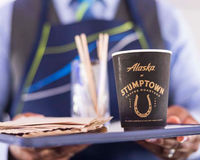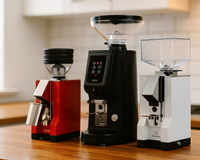French Press or Moka Pot: Which Coffee Contraption Takes the Crown?
Coffee lovers are always on the lookout for new ways to brew the perfect cup of joe. Two popular methods are the French Press and the Moka Pot. In this blog post, we'll compare these two brewing methods and explore the pros and cons of each. Whether you're new to coffee brewing or looking to switch up your routine, read on for our ultimate French Press vs. Moka Pot showdown.
| Aspect | French Press | Moka Pot |
|---|---|---|
| Brewing Process | Immersion brewing | Pressure brewing |
| Grind Size | Coarse | Fine |
| Brewing Time | 4-5 minutes | 5-10 minutes |
| Coffee Strength | Medium to strong | Strong |
| Flavor Profile | Full-bodied, rich, and bold | Strong, espresso-like |
| Ease of Use | Easy | Requires some practice |
| Cleanup | Requires more cleanup | Easy to clean |
| Portability | Bulky and not very portable | Compact and portable |
| Environmental Impact | Grounds and filter paper need to be disposed of properly | Metal filters can be reused, but still produce some waste |
| Cost | Inexpensive | Moderate to expensive |

Please feel free to use this graphic however if you do, please link back to www.cliffandpebble.com
Why should you care about these two brew methods?
Comparing French Press and Moka Pot brewing methods is an important comparison to make for coffee lovers because it allows them to explore different ways of brewing coffee and discover new tastes and flavors. Each brewing method has its own unique characteristics and strengths, which can appeal to different people based on their preferences and needs.
For example, French Press brewing produces a full-bodied, rich, and bold coffee that is great for those who like a strong cup of coffee. On the other hand, Moka Pot brewing produces a strong, espresso-like coffee that can be a good alternative to expensive espresso machines.
Additionally, understanding the differences between these two brewing methods can help coffee lovers make more informed choices about the equipment they purchase and use, as well as the environmental impact of their coffee brewing practices.
Related Post - Can you make espresso in a french press?
In this post...
Here's a preview of the main points that will be covered in the rest of the post:
- Definition and description of French Press and Moka Pot brewing methods
- Comparison of the brewing process, grind size, brewing time, coffee strength, flavor profile, ease of use, cleanup, portability, environmental impact, and cost for each brewing method
- Analysis of the pros and cons of each brewing method
- Consideration of personal preferences and needs when choosing between French Press and Moka Pot brewing methods
- Recommendations for which brewing method might be best for different situations or preferences.
What is a French Press?
A French Press, also known as a press pot or plunger pot, is a type of coffee brewing device that consists of a cylindrical glass or stainless steel container with a plunger and a metal or nylon mesh filter. The plunger is used to press the coffee grounds to the bottom of the container, separating them from the brewed coffee.
To make coffee with a French Press, coarsely ground coffee is added to the bottom of the container, followed by hot water. The coffee and water are left to steep for several minutes, after which the plunger is pressed down slowly to separate the brewed coffee from the coffee grounds. The resulting coffee has a full-bodied flavor and a rich, aromatic aroma.
French Presses come in a variety of sizes, typically ranging from 1 to 8 cups, and can be made of glass, stainless steel, or plastic. They are popular among coffee lovers for their simplicity, versatility, and ability to produce a flavorful cup of coffee without the need for electricity or paper filters.
How a french press works
The brewing process of a French Press involves steeping coarsely ground coffee in hot water, and then pressing down a plunger to separate the brewed coffee from the coffee grounds. Here's a step-by-step guide to the brewing process:
- Boil water and let it cool slightly to around 200°F (93°C).
- Add coarsely ground coffee to the bottom of the French Press. A good starting point is to use a ratio of 1:15 coffee to water (for example, 1 ounce of coffee per 15 ounces of water).
- Pour hot water over the coffee, making sure to saturate all the grounds. Use a circular motion to ensure even extraction.
- Place the plunger on top of the French Press, but do not press down yet.
- Let the coffee steep for 4-5 minutes, depending on the desired strength.
- Slowly press down on the plunger to separate the brewed coffee from the coffee grounds.
The French Press brewing process allows for a longer steeping time and a full immersion of the coffee grounds in the water, resulting in a full-bodied, rich, and flavorful cup of coffee. The metal or nylon mesh filter in the French Press allows some of the coffee oils and sediment to pass through, which can give the coffee a slightly thicker mouthfeel and more complex flavor profile compared to other brewing methods.
The grind size of the coffee also plays a crucial role in the taste of the coffee. Coarser grinds are preferred for French Press brewing to prevent over-extraction and a bitter taste. The water temperature, steeping time, and coffee-to-water ratio can also affect the taste of the coffee. Experimenting with these variables can help achieve the desired strength and flavor profile for your French Press brew.
Pros and Cons of using a French Press

There are several pros and cons to using a French Press to brew coffee. Here are some of the main ones:
Pros:
- Full-bodied flavor: French Press brewing allows for a longer steeping time and a full immersion of the coffee grounds in the water, resulting in a full-bodied and rich flavor profile.
- Aromatic: The French Press allows more of the coffee oils to remain in the final cup, resulting in a more aromatic and complex cup of coffee.
- Versatile: The French Press can be used to brew a variety of coffee types, including light, medium, and dark roasts.
- Environmentally friendly: French Presses do not require paper filters, making them an environmentally friendly option.
Cons:
- Sediment in the cup: The metal or nylon mesh filter in the French Press allows some of the coffee oils and sediment to pass through, resulting in a slightly thicker mouthfeel and some sediment in the final cup.
- Challenging to clean: The mesh filter can be difficult to clean and may require disassembling the plunger to properly clean it.
- Inconsistent brewing: The French Press requires precise measurements and attention to detail to achieve consistent results, which can be challenging for beginners.
- Can be time-consuming: French Press brewing requires a longer steeping time and can take longer to prepare than other brewing methods.
What is a Moka Pot?
A Moka Pot, also known as a stovetop espresso maker, is a coffee brewing device that produces a strong and flavorful coffee that is similar in taste and texture to espresso. It was invented in Italy in the 1930s by Luigi De Ponti and has since become a popular method of brewing coffee in Europe and Latin America.
The Moka Pot consists of three parts: a bottom chamber for water, a middle chamber for finely ground coffee, and a top chamber for the brewed coffee. To make coffee with a Moka Pot, water is added to the bottom chamber and finely ground coffee is added to the middle chamber. The Moka Pot is then placed on a stove and heated, which causes the water to boil and the steam to rise through the coffee, extracting its flavor and aroma. The brewed coffee then collects in the top chamber of the Moka Pot.
Available in many different sizes, capacities, and even cool colors, Moka Pots range from single-cup to twelve-cup models, and are made of aluminum, stainless steel, or copper. They are popular among coffee lovers for their ability to produce a strong and flavorful coffee without the need for expensive equipment or electricity. They are also relatively easy to use and require minimal cleanup.
How do they work and what does it taste like?

The brewing process of a Moka Pot involves passing pressurized steam through finely ground coffee, resulting in a strong and flavorful coffee that is similar in taste and texture to espresso. Here's a step-by-step guide to the brewing process:
- Fill the bottom chamber of the Moka Pot with water up to the safety valve. Use cold water and avoid filling the chamber too much, as this can result in over-extraction and a bitter taste.
- Insert the middle chamber into the bottom chamber and fill it with finely ground coffee. The coffee should be compacted slightly, but not too tightly, to ensure proper extraction.
- Screw the top chamber onto the middle chamber, making sure it is tightly sealed.
- Place the Moka Pot on a stove over medium heat. The water in the bottom chamber will boil, creating steam that will pass through the coffee grounds and into the top chamber.
- As the coffee begins to brew, the top chamber will fill with coffee. Remove the Moka Pot from the stove as soon as the coffee stops flowing into the top chamber.
- Pour the brewed coffee into a cup and enjoy.
The Moka Pot brewing process produces a strong and full-bodied cup of coffee that is similar in taste and texture to espresso. The steam generated by the boiling water in the bottom chamber extracts the flavor and aroma of the coffee, resulting in a strong and intense flavor profile. The fine grind size of the coffee allows for more surface area to be exposed to the steam, which enhances the extraction process.
The Moka Pot brewing process also requires careful attention to the water temperature, coffee-to-water ratio, and grind size. If the water temperature is too high or the coffee is ground too fine, the coffee can become over-extracted and bitter. If the water temperature is too low or the coffee is ground too coarse, the coffee can be weak and under-extracted. Experimenting with these variables can help achieve the desired strength and flavor profile for your Moka Pot brew.
Pros and Cons of Moka Pot brewing

Pros:
- Strong and flavorful coffee: The Moka Pot brewing process produces a strong and flavorful coffee that is similar in taste and texture to espresso.
- Easy to use: The Moka Pot is relatively easy to use and requires minimal cleanup.
- Inexpensive: The Moka Pot is an affordable option for brewing strong and flavorful coffee at home.
- Versatile: The Moka Pot can be used to brew a variety of coffee types, including light, medium, and dark roasts.
Cons:
- Requires a stovetop: The Moka Pot requires a stovetop to brew coffee, which can be inconvenient if you don't have access to a stove or if you are traveling.
- Requires precise measurements: The Moka Pot requires precise measurements of coffee and water to achieve consistent results, which can be challenging for beginners.
- Potentially hazardous: The Moka Pot uses steam and pressure to brew coffee, which can be potentially hazardous if not used properly. It is important to follow the manufacturer's instructions carefully and to avoid touching the hot surface of the Moka Pot.
- Can be difficult to clean: The small parts and crevices of the Moka Pot can be difficult to clean and may require disassembling the device to properly clean it.
French Press vs. Moka Pot Comparison
Taste Differences
The taste and flavor profile of coffee brewed using a French Press and a Moka Pot are different due to the unique brewing processes of each method.
Coffee brewed with a French Press has a full-bodied flavor and a rich aroma due to the longer steeping time and full immersion of the coffee grounds in the water. The metal or nylon mesh filter allows some of the coffee oils and sediment to pass through, resulting in a slightly thicker mouthfeel and a more complex flavor profile compared to other brewing methods. The French Press can produce a variety of flavor profiles depending on the coffee used, the grind size, and the water temperature.
In contrast, coffee brewed with a Moka Pot has a strong and intense flavor profile that is similar to espresso. The steam generated by the boiling water in the bottom chamber extracts the flavor and aroma of the coffee, resulting in a strong and full-bodied cup of coffee. The fine grind size of the coffee allows for more surface area to be exposed to the steam, which enhances the extraction process. The Moka Pot can produce a variety of flavor profiles depending on the coffee used, the grind size, and the water temperature.
Overall, the French Press produces a full-bodied and aromatic cup of coffee with a more complex flavor profile, while the Moka Pot produces a strong and intense cup of coffee that is similar in taste and texture to espresso. The choice between the two methods ultimately depends on personal taste preferences and desired flavor profile.
Brewing Time Comparison

The brewing time and convenience of using a French Press and a Moka Pot differ due to the unique brewing processes of each method.
French Press - 4 to 5 minutes depending on recipe.
Moka Pot - 5 to 10 minutes
A French Press typically requires a brewing time of 4-5 minutes, which includes steeping time and the pressing of the plunger to separate the brewed coffee from the coffee grounds. The brewing process can be relatively hands-off during the steeping time, but does require attention when pressing the plunger. The cleanup process can be a bit more involved due to the need to disassemble and clean the plunger and mesh filter. However, the French Press is a convenient option for coffee lovers who want a flavorful cup of coffee without the need for electricity or paper filters.
In contrast, a Moka Pot typically requires a brewing time of 5-10 minutes, which includes the time needed for the water in the bottom chamber to boil and the steam to pass through the coffee and into the top chamber. The brewing process requires close attention to the water temperature, coffee-to-water ratio, and grind size to achieve consistent results. The Moka Pot requires minimal cleanup compared to the French Press, with most parts being easily washable with soap and water. However, the Moka Pot requires a stovetop to brew coffee, which can be inconvenient if you don't have access to a stove or if you are traveling.
Overall, the French Press is a convenient option for those who want a flavorful cup of coffee without the need for electricity or paper filters, but does require more cleanup time. The Moka Pot requires more attention to the brewing process, but is a convenient option for those who have access to a stove and want a strong and flavorful cup of coffee that is similar in taste and texture to espresso.
Environmental Impact
When considering the environmental impact of coffee brewing methods, there are a few factors to consider, including the use of paper filters, the energy source used to heat the water, and the overall waste produced during the brewing and cleanup process.
In terms of paper waste, the French Press is an environmentally friendly option since it doesn't require paper filters. The metal or nylon mesh filter can be reused many times, reducing the amount of waste produced during the brewing process. However, the use of electricity or gas to heat the water can contribute to carbon emissions and environmental impact.
The Moka Pot also doesn't require paper filters, which is a plus for the environment. However, it does require a stovetop to heat the water, which can contribute to energy usage and carbon emissions. Additionally, the aluminum or stainless steel material of some Moka Pots can have an environmental impact due to the manufacturing process.
Which method is right for you?
To summarize the pros and cons of each brewing method:
French Press Pros:
- Full-bodied flavor
- Aromatic
- Versatile
- Environmentally friendly
French Press Cons:
- Sediment in the cup
- Challenging to clean
- Inconsistent brewing
- Can be time-consuming
Moka Pot Pros:
- Strong and flavorful coffee
- Easy to use
- Inexpensive
- Versatile
Moka Pot Cons:
- Requires a stovetop
- Requires precise measurements
- Potentially hazardous
- Can be difficult to clean
Ultimately, the choice between a French Press and a Moka Pot will depend on personal taste preferences and brewing preferences. The French Press is a good option for coffee lovers who want a full-bodied and aromatic cup of coffee, while the Moka Pot is ideal for those who want a strong and flavorful cup of coffee that is similar in taste and texture to espresso. Both methods have their pros and cons, and it is important to consider factors such as convenience, ease of use, and environmental impact when choosing a brewing method.
-----















